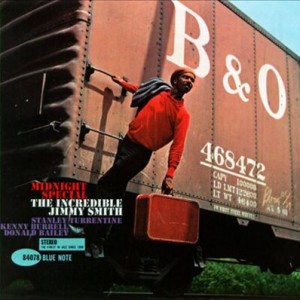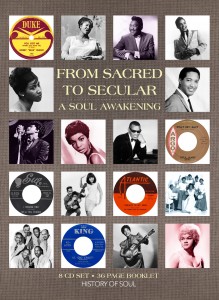An undeniable musical, cultural, and political cornerstone of America, soul music blended blues, gospel, jazz and rhythm & blues in a cauldron and formed the launching pad for an incredible number of genres and had a direct hand in the formation of pop to rock to disco to house. The story of soul and it’s history is rich and diverse, and it tells the quintessential story of people rising above, and using notes to soothe their woes.
Soul brought people together, and it comes as no surprise that it brought Nick Duckett and Stewart Tippett together. Individually, each of them carried a wealth of knowledge and experience musicians, historians and all round black music lovers to, and together they brought their experience and love to launch History of Soul Records: comprehensive series of double CDs chronicling the evolution of soul from its beginnings in the churches of the southern states through the dance halls of the chittlin’ circuit to the sophisticated supper clubs of the urban centres.
We sat down with one half of the team, Mr Stewart Tippett, to hear more about the label, and learn more about the genre.
MN: How would you describe soul music to someone unfamiliar with the genre and sound?
ST: Soul music hits you in the heart because it’s inspirational, spiritual, and connects with everyday emotions and feelings that we can all relate to. It’s a genre that joins us because it speaks to the human condition.
MN: What was the spark that led to creating the site? And, how did the collaboration begin and develop?
ST: We really noticed an absence of the narrative of the beginnings of soul’s history, particularly how gospel’s role has been casually overlooked in the genre’s evolution. This, combined with a love of the genre shared by myself and Nick Duckett (my partner on this label and also founder of History Of RnB Records, on which I collaborate), were the ingredients that created the spark for History Of Soul Records.
MN: How did you meet your collaborator, Nick, and what occurred in your first encounter the began the chain reaction that lead to the site?
ST: Nick and I have been friends for decades, and we met through our mutual love of black music, and through playing in various bands over the year, as well as going to gigs, record fairs and many a good night out with excellent tunes. With our combined experience, study, and passion accumulated over the years in soul, jazz and R&B, it was evident to us both that there really was no definitive narrative telling the whole story of the evolution of either R&B or soul. We felt strongly that we wanted to create a label that would address that. I consulted for Nick on the founding of RnB Records, and it was natural to ask Nick to join forces with me on History Of Soul to ensure this essential narrative was told with the right depth of sleeve notes and, above all, the right variety of tracks. We’re strictly a “no filler” label.
MN: What was the first compilation you both worked on?
ST: Chicago Soul & Wade In The Water were our first History Of Soul collaborations (History Of Soul Chronology Volume 1).
MN: Can you provide us with a glimpse of your work when it comes to releasing a compilation record such as your upcoming “From Sacred to Secular: A Soul Awakening” anthology, and how the process moves from concept, to song selection and actual release?
ST: We really wanted our customers and all fellow soul enthusiasts to have the opportunity to own a definitive box set that not only incorporated the research, knowledge and track choices available across individual CDs on the label, but drew all threads together and made it very easy to follow the social, historical, and musical journey of soul from its “sacred” roots in the church (specifically the [Pentecostal] Holiness Churches – Church Of God [in] Christ – COGIC), right through to its development into a far reaching “secular” and popular incarnation.
The genre has touched so many. That was the concept, and so the tough-but-fun task of track selection began! It’s never easy. The breadth and depth of soul music makes it the best of challenges in my opinion and it’s a process I love – re–discovering classics, introducing rare tracks to an enthusiastic audience, and sharing how they fit as integral to the overall history of the genre. Tough choices and cuts need to be made, but Nick and I are delighted to have brought together a piece of work that truly offers a great introduction and insight into the evolution of soul.
MN: Browsing through the site, I have to say that the selections are beyond fantastic. I like to think of myself as a soul and jazz connoisseur, but I’ve come across musicians and songs I’ve never heard before, and that joy of discovery is one of the biggest thrills a music fan can have. Do you still find yourself, as a well-versed curator, able to unearth music from that golden era and experience that unique sensation?
ST: Thanks very much, that’s great to hear! I still revel in the joy of discovering new tracks, their backstories, and new information on artists. It’s what I thrive on, and I am always looking forward to my next discovery.
MN: I got extremely excited when I read your first music experiences involved Blue Note Records. My father was a huge jazz fan, and my first vivid memory is listening to Dave Brubeck’s “Take Five”, so jazz has completely defined my life to this day in more than one way. Can you tell us more about that first encounter both as kid and an adult?
ST: From the first bars, I loved the jazz recordings on Blue Note, Capitol, Columbia, and other labels when I heard them through the walls of my dorm. I have particularly fond memories as a young boy of Lee Morgan’s “Sidewinder” and tracks by Stanley Turrentine. I didn’t know the name of all the tracks in those days and it was later as I matured that I recognised the tunes and matched them to the tracks and the artists’ stories. My love for the impact the first hearings had on me has only grown as I have. I’ve grown up with Miles Davis and so many others. We form our own personal soundtracks to artists, labels and tunes – it’s truly a gift.
MN: The work Alfred Lion, Francis Wolff and Max Margulis did on Blue Note revolutionised how people viewed record labels. In particular, the collaboration between Wolff’s photography and Reid Miles’ iconic graphic designs to design the album covers was every bit as influential as the music. Can you share some of your favourite album covers, and some underrated records from the label?
ST: One of my favourite covers is the incredible Jimmy Smith’s “Midnight Special” (Blue Note 4078).
These recordings produced two classic albums, from which “Back At The Chicken Shack” is an all-time favourite with the stunning playing of Stanley Turrentine and favourite Blue Note guitarist Kenny Burrell. The cover has Jimmy Smith climbing onto an B&O (Baltimore & Ohio Railway) freight train with a suitcase in his hand. As an interesting footnote, Andy Warhol produced a short series of designs for Blue Note, notably Johnny Griffin’s “The Congregation” (Blue Note 1543) and a Kenny Burrell Album too. These are well worth tracking down to look at. An underrated Album is “Shouting” by Don Wilkinson (Blue Note 4145), this album features the Tenor Sax playing of Ray Charles’s early saxman who has a big Texas sound and infuses that with a great gospel feel. The cover itself is a great example of a series that featured artists like Freddie Hubbard’s Hubtones and more.
MN: Soul music, as with jazz are the quintessential American art form and their influence continues to this day. Jazz undeniably had a hand in the development of progressive and experimental rock, soul-influenced disco and dance music (notably house), both define hip hop. Did you ever imagine that a sound that grew from African-American blues and gospel roots would have such a monumental impact on the world and across so many genres?
ST: If I measure the genre’s impact on me personally – both spiritually, musically and intellectually, it’s no surprise to me at all that soul’s reach and influence across the decades is felt in so many different genres, all to different tastes. Rap in particular had been with us for some time and was influenced by soul’s spirit and beats, whereas disco was a fantastic new energy that digressed into a more predictable commercial genre. Simple soul sampling of course is the most easily identifiable link to hip hop and house.
MN: What makes soul so unique, from both a cultural standpoint, and for you personally?
ST: Its sound, its feel, and its raw depth still give me goosebumps upon my goosenbumps! It’s part of my heritage and personal history. It’s the only genre that does – so it’s personally unique in that respect. From a cultural standpoint, it’s a genre unique in its the potency and consistency of its soundtrack presence in the African-American socio-political narrative, from civil rights and Vietnam, to police brutality and America’s current racial crisis. From “What’s Going On” and “A Change Is Gonna Come” to NWA’s “Straight Outta Compton”, this is a genre unique in its constant role as commentator.
MN: As I mentioned before, the site is a gold mine! What are some of your most treasured finds, and how did you come across them?
ST: By Listening and corresponding with fellow enthusiasts and connoisseurs, we have had so many musical treasures discovered, and it’s an incredible joy. It would be so hard to choose, but I’ll try! Particularly treasured finds include: Al “TNT” Braggs’ Original Version of “Cigarettes & Coffee”, Nappy Brown’s original version of “The Right Time” and O.V. Wright’s “Sit Down And Rest A While” with the Sunset Travellers.
MN: Which release would you recommend for a first time visitor, and why?
ST: I’d recommend “Singing From My Soul” (History Of Soul Volume five) because it fully incorporates the transition of gospel into Soul, and thus marks a landmark point in the genre’s journey. The gospel shouts of the Isley Brothers recording of “Shout- Parts 1 & 2”, Ray Charles’s dynamic sermonising in “What I Say – Parts 1 &2” and The Swan Silvertones “Singing From My Soul” (Almost a deep soul ballad merged with a personal spiritual cry from a gospel vocal group) are great examples on this CD of gospel/soul as Sunday Morning Church singing evolves into Soul. In short, this is the point at which the sacred becomes the secular. Talking of which, we have some great news at History Of Soul Records: Available for pre-order and delivery before Christmas at historyofsoul.net, is our 8 CD Box Set “From Sacred To Secular – A Soul Awakening”, in a luxury DVD-sized hard cover format.
MN: Are there any current musicians that you listen to that are keeping that soulful sound alive and current?
ST: Absolutely: Aloe Blacc, John Legend, Maxwell, Angie Stone, and Macy Gray.
MN: Finally, What are 10 records in your collection that you believe everyone should listen to at least once?
ST: That’s very tough! On LP:
1. James Brown “Live At The Apollo”
2. Marvin Gaye “What’s Going on”
3. Howard Tate “Get it While you can”
6. Aretha Franklin “I Never Loved A Man The Way I Loved You”
7. Esther Philips “From a Whisper To A Scream”
8. The Davis Sisters “ The Famous Davis Sisters Of Philadelphia (Savoy Records)” The Temp
9. Bobby Bland “Two Steps From The Blues”
10. The Temptations “ Temptin’”
And I have to add to “bonus” on 45:
1. Junior Walker & The All Stars “ Road Runner”
2. Daryl Banks “Open The Door To Your Heart”
You can find out more about, and purchase, Stewart and Nick’s soul anthology at historyofsoul.net.
From Sacred to Secular: A Soul Awakening, and the 8-CD anthology, The History of Soul, is out on 27 November 2015. Preview some tracks on their Soundcloud.
Check out our edit of selected music from this interview in History of Soul pt.1 and History of Soul pt. 2.
Aretha Franklin illustration by Martín Echevarría.

















No Comments